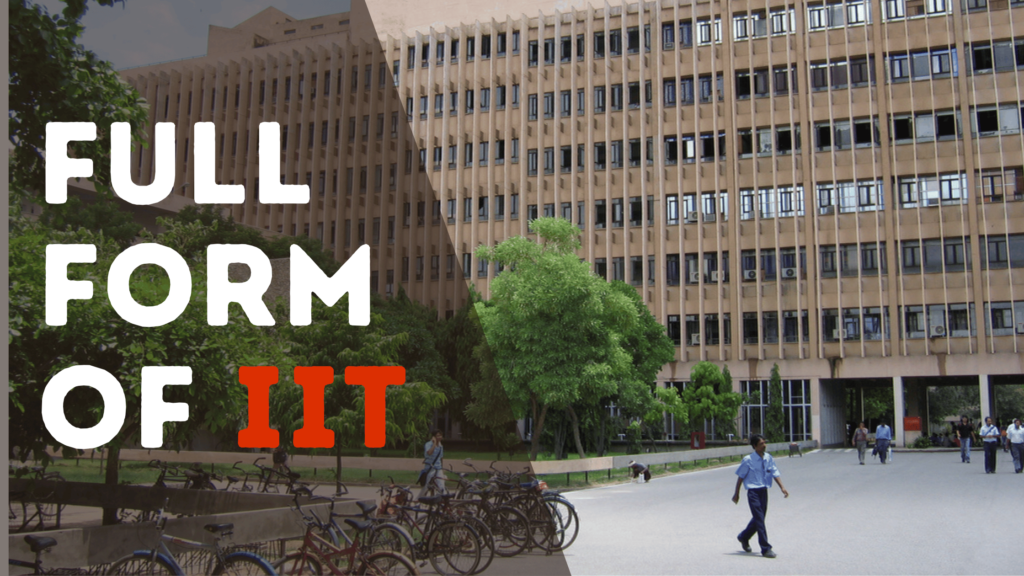Full Form IIT
Students wondering about the full form of IIT should understand that it stands for Indian Institute of Technology. Known as IITs, these institutions form a network of public technical universities spread across India, operating under the supervision of the Government of India’s Ministry of Education.

Overview of IITs
The Indian Institutes of Technology (IIT Full Form) are among the most reputed educational entities in India, offering higher education in different engineering disciplines. There are 23 IITs across India, each functioning as an autonomous institution under the Institutes of Technology Act, 1961.
What is the full form of IIT?
The full form of IIT is “Indian Institute of Technology.” It is a prestigious group of higher education institutions in India, renowned for offering quality education in various engineering disciplines.
Courses Offered
IITs provide a range of undergraduate, postgraduate, and doctorate programs in fields like science, engineering, and technology. These include Bachelor of Science, Dual Degree (B.Tech and M.Tech), Bachelor of Architecture (B.Arch), Bachelor of Design (B.Des), and various master’s and doctoral programs.
The Indian Institutes of Technology (IIT Full Form) offer a diverse range of courses. Below is a table listing some of the major courses available across various IITs:
| IIT Location | Undergraduate Courses | Postgraduate Courses |
|---|---|---|
| IIT Kharagpur | B.Tech, B.Arch | M.Tech, MBA, M.Sc |
| IIT Bombay | B.Tech, B.Des | M.Tech, M.Des, M.Phil |
| IIT Madras | B.Tech, Dual Degree | M.Tech, MS, MBA |
| IIT Kanpur | B.Tech, BS | M.Tech, M.Sc, MBA |
| IIT Delhi | B.Tech, Dual Degree | M.Tech, MS, MBA |
| IIT Guwahati | B.Tech, B.Des | M.Tech, M.Des, MA |
| IIT Roorkee | B.Tech, B.Arch | M.Tech, MBA, M.Arch |
| IIT Hyderabad | B.Tech, Dual Degree | M.Tech, M.Des, M.Phil |
| IIT Gandhinagar | B.Tech, Dual Degree | M.Tech, MA, M.Sc |
| IIT Ropar | B.Tech | M.Tech, MS, M.Sc |
| IIT Bhubaneswar | B.Tech, Dual Degree | M.Tech, M.Sc |
| IIT Patna | B.Tech | M.Tech, M.Sc |
| IIT Indore | B.Tech, BS | M.Tech, MS, M.Sc |
| IIT Mandi | B.Tech | M.Tech, MS |
| IIT BHU Varanasi | B.Tech, B.Pharm | M.Tech, MBA, M.Pharm |
| IIT Dhanbad | B.Tech, Dual Degree | M.Tech, MBA, M.Sc |
| IIT Palakkad | B.Tech | M.Tech, MS |
| IIT Tirupati | B.Tech | M.Tech |
| IIT Goa | B.Tech | M.Tech |
| IIT Jammu | B.Tech | M.Tech |
| IIT Dharwad | B.Tech | M.Tech |
| IIT Bhilai | B.Tech | M.Tech |
| IIT Jodhpur | B.Tech | M.Tech, M.Sc |
Please note that this table is a general representation and may not include every course offered by each IIT. The availability of courses can vary, and new programs may be introduced. For the most accurate and up-to-date information, it’s recommended to visit the official website of each IIT.
Admission Process
Admission to IITs is highly competitive. Candidates must score at least 75% in their PCM board exams (criteria may vary based on reservation). The Joint Entrance Examinations (JEE Main and JEE Advanced) conducted by the National Testing Agency (NTA Engineering Exam) are the gateway to IITs. The Joint Seat Allocation Authority (JoSAA) conducts the counselling process for admission, where the JEE Advanced score plays a crucial role.
Significance of IIT Education
The rigorous selection process and the quality of education at IITs highly value their education. Top companies and research institutions worldwide often seek IIT graduates for their technical expertise.
Education at IITs equips students with a scientific approach and critical thinking skills to address global challenges. IITs have a significant and active global alumni network, and their faculty and graduates have made notable contributions in various fields.
List of IITs
As of 2023, there are 23 Indian Institutes of Technology (IIT Full Form) across India. Here is a list of all the IITs:
- IIT Kharagpur (West Bengal)
- IIT Bombay (Maharashtra)
- IIT Madras (Tamil Nadu)
- IIT Kanpur (Uttar Pradesh)
- IIT Delhi (Delhi)
- IIT Guwahati (Assam)
- IIT Roorkee (Uttarakhand)
- IIT Bhubaneswar (Odisha)
- IIT Gandhinagar (Gujarat)
- IIT Hyderabad (Telangana)
- IIT Jodhpur (Rajasthan)
- IIT Patna (Bihar)
- IIT Ropar (Punjab)
- IIT Indore (Madhya Pradesh)
- IIT Mandi (Himachal Pradesh)
- IIT (BHU) Varanasi (Uttar Pradesh)
- IIT Palakkad (Kerala)
- IIT Tirupati (Andhra Pradesh)
- IIT (ISM) Dhanbad (Jharkhand)
- IIT Bhilai (Chhattisgarh)
- IIT Goa (Goa)
- IIT Jammu (Jammu & Kashmir)
- IIT Dharwad (Karnataka)
These institutes, known for their excellence in science, engineering, and technology education and research, are autonomous yet linked by the IIT Council. They significantly contribute to driving India’s technological innovation and development.
Frequently Asked Questions
IITs (Indian Institutes of Technology) are a group of autonomous public technical and research universities, governed and funded by the Government of India. They are not private institutions.
There is no specific age limit for appearing in the JEE (Joint Entrance Examination) Main. However, candidates must have completed their 10+2 or equivalent examination in the last two years or be appearing in the current academic year to be eligible for JEE Main. For JEE Advanced, there might be additional criteria, including age limits, which candidates should verify from the official JEE Advanced notification.
Candidates must clear the Joint Entrance Examination (JEE), conducted in two stages, to gain admission into the Indian Institutes of Technology (IITs). These two stages are:
JEE Main: The first stage of the examination. Candidates must qualify in this exam to be eligible for the next stage.
JEE Advanced: Only those who rank among the top candidates in JEE Main are eligible to appear for JEE Advanced. Admission to IITs is based on the candidate’s performance in JEE Advanced, subject to meeting other eligibility criteria.
Clearing these exams, especially JEE Advanced, is essential for securing admission into undergraduate engineering programs at the IITs.
Leave a Reply